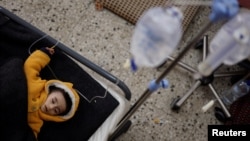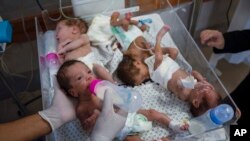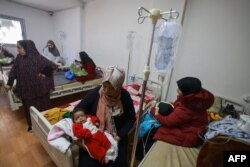More than a dozen children in Gaza have starved to death, and many more are at risk as malnutrition soars, infectious diseases spread, and urgently needed life-saving humanitarian aid is blocked from entering the Palestinian enclave, U.N. aid agencies warn.
“As of 3 March, the Ministry of Health in Gaza reports that 15 children have died of malnutrition and dehydration at Kamal Adwan Hospital, the only pediatric hospital in northern Gaza, and expressed fear for the lives of six other infants who are suffering from acute malnutrition,” said Dr. Rik Peeperkorn, representative for the World Health Organization in occupied Palestinian areas, citing the Hamas-controlled agency.
Speaking from his post in Jerusalem, Peeperkorn told journalists in Geneva on Tuesday that without a sustained cease-fire, “2.2 million people in Gaza are in the midst of an epic catastrophe and facing inhumane conditions.”
“There is a risk of famine. There is a risk of disease. There is an enormous amount of desperation, and the scarcity has led to a regular breakdown of law and order,” Peeperkorn said, adding that internally displaced people are facing acute shortages of food, water, shelter and medicine.
This is borne out by a group of WHO officials who teamed up with partners to access Al-Awda and Kamal Adwan hospitals in northern Gaza over the weekend, the first visit since Hamas militants invaded Israel on October 7, unleashing a fierce offensive by Israel in the Gaza Strip.
Dr. Ahmed Dahir, head of WHO’s Gaza sub-office, said the journey to the north is indescribable.
“Every time you think it cannot worsen, it does. No photos or videos can truly capture the devastation that has unfolded in Gaza,” he said.
“Enroute to the hospitals, desperate crowds searching for food approached our truck and surrounded it,” Dahir said “We had to use our megaphones to inform them that we were only carrying medical supplies in order to proceed. It is heartbreaking to see the hospitable people of Gaza reduced to such desperation.”
Dahir said the situation in the hospitals is equally dire. He said health workers and patients are barely surviving on one basic meal a day. He said both hospitals faced shortages of fuel, power and specialized staff to treat the many trauma cases admitted.
“Thanks to supplies provided over the weekend,” some of the services that no longer were operational “were able to restart,” he said.
Arriving at Al Shifa hospital, Gaza’s largest medical complex, the team delivered fuel, life-saving medicine and treatment for children suffering from severe acute malnutrition, according to Peeperkorn, who said it had been more than a month since WHO officials had reached the facility.
While critical, Peeperkorn called the deliveries only “a fraction of the urgent life-saving needs.”
“We appeal for sustained humanitarian access,” he said. “The deconfliction mechanism needs to continue working so aid can reach those in need.”
Jens Laerke, spokesperson for the U.N.’s Office for the Coordination of Humanitarian Affairs, agreed on the importance of scaling up deliveries of humanitarian aid commensurate with the enormous need.
“Now, when children are starving as the doctors are telling our colleagues. Now, when they are dying, that should be an alarm like no other," Laerke said.
“If not now, when is the time to pull the stops, break the glass, flood Gaza with the aid that it needs? So, that is what we need to see happen,” he said.
Over the past three days, Laerke said some 130 aid trucks have crossed daily through the Rafah crossing in the south, bordering Egypt. Before the war in Gaza began, he said about 500 trucks of humanitarian aid entered the enclave every day.
U.N. aid agencies are calling on Israel to open the Erez crossing point to allow goods to enter northern Gaza, which has been largely cut off from humanitarian aid since November.
In a statement Sunday, Adele Khodr, UNICEF’s regional director for the Middle East and North Africa, said, “The child deaths we feared are here and are likely to rapidly increase unless the war ends and obstacles to humanitarian relief are immediately resolved.”
She attributed the recent deaths of children in Kamal Adwan Hospital to “dehydration and malnutrition.”
“There are likely more children fighting for their lives somewhere in one of Gaza’s few remaining hospitals, and likely even more children in the north unable to obtain care at all,” she said. “These tragic and horrific deaths are man-made, predictable and entirely preventable.”
January malnutrition screenings by UNICEF and the World Food Program in the north found that nearly 16% of children under 2 years of age — or one in six — are acutely malnourished.
Similar screenings conducted in the south in Rafah, where aid has been more available, found 5% of children under 2 years are acutely malnourished.
Acutely malnourished children have weakened immune systems and face an increased risk of serious illness and death, primarily from acute infectious diseases.
“We have been concerned since November that because of the lack of clean water and the desperate lack of nutrition … we are seeing these deaths that we long feared,” said UNICEF spokesperson James Elder.
“Because we cannot get aid in, the malnutrition in the north is three times higher than those in Rafah,” he said. “So, there is some evidence that when that trickle of aid can come in, it does make a life-saving difference.














